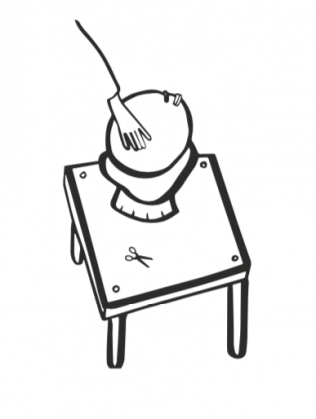Drawn into the Conversation
What is it to be drawn into a conversation? I had the most intriguing one recently, convened by Javiera Hiault-Echeverria in the context of her last exhibition, entitled Out of This Same Light (‘Fuera de Esta Misma Luz’), held in December 2019, at the NAC gallery in Santiago. The conversation included, in addition to Javiera, three artists (Renato Ordenes, José Pedro Godoy and Felipe Muhr), an art historian (José de Nordeflych) and me, an anthropologist, all of whom have cultivated an interest in, and mostly a practice through, drawing. The theme was drawing, of course, which has been particularly significant in Javiera’s work. Yet, to our surprise, the conversation itself took place, literally, through drawing! On the meeting table there were sheets of paper and pencils calling us to the gathering.
Knowing in advance what the conversation entailed would have most certainly spoiled the occasion. The conversation was a process of re-discovery. We were not just conveying information we already knew, emitting sounds from our mouths. In tracing lines not just on paper but, most notably, in open air – as we spoke using our hands and fingers – we were drawing each other’s attention. Being drawn into the conversation was a process whereby we, practitioners of different crafts, learned to attend to each other’s interests as we crafted, quite literally, a path together.
In holding the pencil against the paper, line and surface emerged in tandem, an experience shared even by those like me, unaccustomed to the art of improvised drawing. So, we wondered, is there really a difference between drawing on paper and gesturing with our hands in the air as we speak? If surface and trace were co-emergent in our storytelling, how could we draw a sharp line between those vanishing traces that emerged through the movements of our fingers in the gaseous medium that filled the room and the conversational gestures that inscribed with charcoal the forking and often convoluted paths of our jointly drawn attention?
Arguing that one of them classified more distinctively as drawing was ultimately absurd. How about the sand drawings that Navajo people perform, the particles of which are destined to be eroded by the wind? Or the line left by a canoe crossing a lake, destined to disappear in-between the waves? Or the lines airplanes make as they rush through the vanishing canvas of condensed vapour that form clouds? The co-occurrence of line and surface is a matter of degree, ranging in spectrum from the solid to the vaporous.
In such a context, it did not matter, that some of us had no formal training in drawing. Ultimately, we had all been born artists, endowed with a capacity to draw people’s attention and be drawn into a conversation through gestures. Gestures are at the core of everyday conversation for how, for instance, they contribute significantly to index and materialise our references to the world. Moreover, gestures have co-evolved with language to a point where the former are regarded as responsible for setting the conditions for emergence of the latter in evolution. Perhaps similarly, we could say this of the distance between rock art and written language, marking the transition from pre-history to history in human social evolution. Breaking with such entrenched ideas, we most certainly required getting out of the view, well-established in western formal education, that doing intelligent things – like drawing, yet most distinctively writing – involved the externalization of pre-conceived mental images. Otherwise, our conversations – hand gestured, drawn or written, for that purpose – would have been just the ghostly retrospection of what each of us had carried there into that room, that evening, before entering it.
This is, I believe, what is at the core of this remarkable exhibition by Javiera, the person responsible for intuitively assembling this unique interdisciplinary gathering. To me, the drawings that composed Out of This Same Light are not aimed at communicating a preconceived message that formerly lay in someone’s head, waiting to be interiorized by a spectator. Javiera’s drawings are instead an invitation to be drawn attentively into a conversation, with no pre-established beginnings or ends. Their characteristic openness is part of an ongoing call to see the world anew, that is, simultaneously with new eyes and in new light, letting yourself be drawn, once again, into unknown territory.
Para Fuera de esta misma luz, Javiera Hiault-Echeverria, NAC Chile 2018
